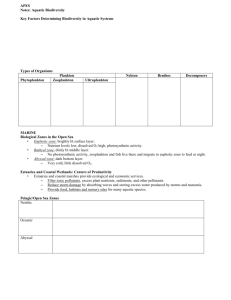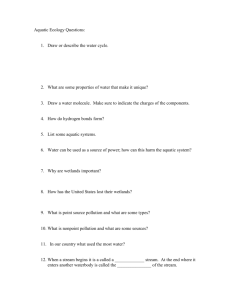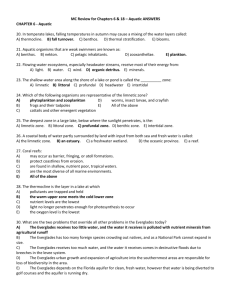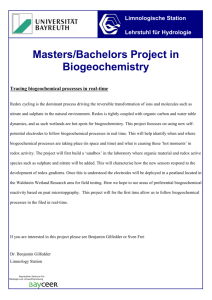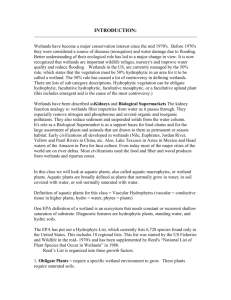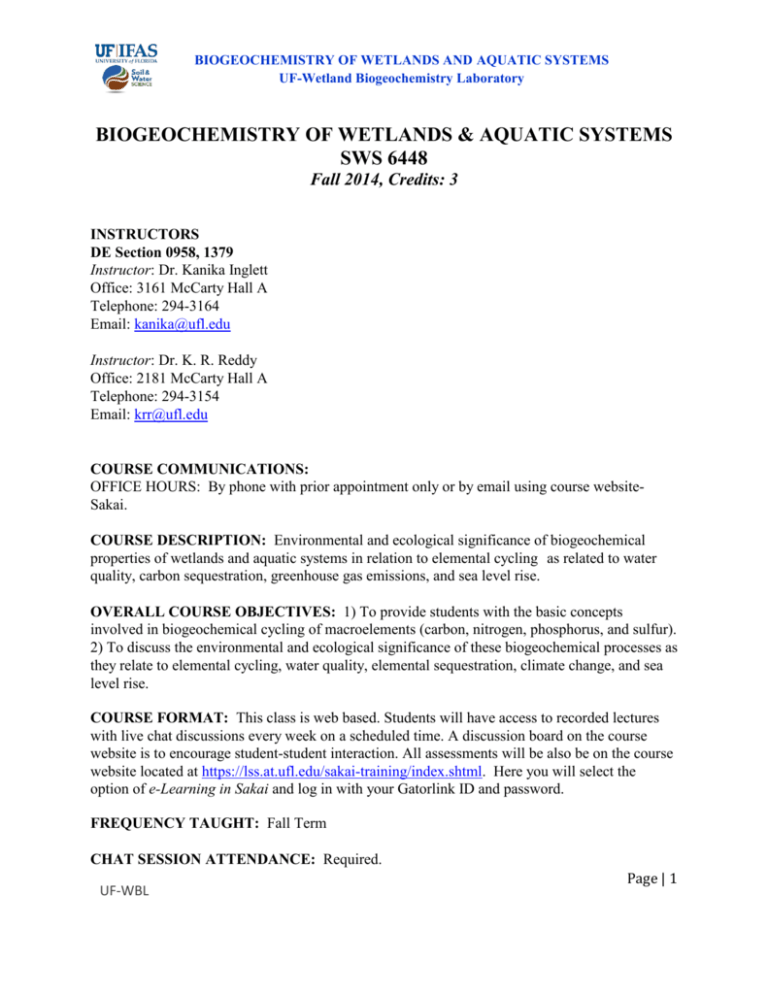
BIOGEOCHEMISTRY OF WETLANDS AND AQUATIC SYSTEMS
UF-Wetland Biogeochemistry Laboratory
BIOGEOCHEMISTRY OF WETLANDS & AQUATIC SYSTEMS
SWS 6448
Fall 2014, Credits: 3
INSTRUCTORS
DE Section 0958, 1379
Instructor: Dr. Kanika Inglett
Office: 3161 McCarty Hall A
Telephone: 294-3164
Email: kanika@ufl.edu
Instructor: Dr. K. R. Reddy
Office: 2181 McCarty Hall A
Telephone: 294-3154
Email: krr@ufl.edu
COURSE COMMUNICATIONS:
OFFICE HOURS: By phone with prior appointment only or by email using course websiteSakai.
COURSE DESCRIPTION: Environmental and ecological significance of biogeochemical
properties of wetlands and aquatic systems in relation to elemental cycling as related to water
quality, carbon sequestration, greenhouse gas emissions, and sea level rise.
OVERALL COURSE OBJECTIVES: 1) To provide students with the basic concepts
involved in biogeochemical cycling of macroelements (carbon, nitrogen, phosphorus, and sulfur).
2) To discuss the environmental and ecological significance of these biogeochemical processes as
they relate to elemental cycling, water quality, elemental sequestration, climate change, and sea
level rise.
COURSE FORMAT: This class is web based. Students will have access to recorded lectures
with live chat discussions every week on a scheduled time. A discussion board on the course
website is to encourage student-student interaction. All assessments will be also be on the course
website located at https://lss.at.ufl.edu/sakai-training/index.shtml. Here you will select the
option of e-Learning in Sakai and log in with your Gatorlink ID and password.
FREQUENCY TAUGHT: Fall Term
CHAT SESSION ATTENDANCE: Required.
UF-WBL
Page | 1
BIOGEOCHEMISTRY OF WETLANDS AND AQUATIC SYSTEMS
UF-Wetland Biogeochemistry Laboratory
ASSESMENTS:
MODULAR QUIZZES
EXAMS
PRESENTATIONS
SPECIAL ASSIGNMENT
ATTENDANCE/DISCUSSION
Passing
Grade
A
A-
B+
B
25%
50% (25%x2)
15%
5%
5%
B-
C+
C
C-
D
D
Points (%) 93-100 90-92 86-89 83-86 80-82 76-79 73-75 70-72 66-69 63-65
E
<63
MODULAR QUIZZES: (25% of final grade): Modules (1-8) are associated with chapters 3 to 11
and they will be covered in regular lectures. All students are expected read these chapters.
Associated with each module will be quizzes and homework problems that must be completed
within specified time period (as directed by the instructors)
EXAMS: (50% of final grade): Your understanding of the material will be assessed with two
exams (25% each) during the semester. Exam format is primarily as a few short objective type
questions (multiple choice, fill in the blanks), short answers (4-5 sentences) and long discussion
type questions. However, this can be modified as per the discretion of the instructor and will be
explained at appropriate time.
PRESENTATIONS: (15% of final grade): Each student is expected to present a concept (list of
topics will be provided by the instructors, and will be either from reading assignments or from
current literature pertinent to this course) by developing a 15 minute presentation. Presentations
will be made using the Voice Thread technology. A 2 minute tutorial can be found at
https://ufl.voicethread.com. Follow the instructions provided there. Each presentation will be
reviewed by the whole class. Setailed instructions will be provided in chat sessions. All
presentations are considered to be part of the final exam and scheduled during the final exam
week. Material from chapters 14, 15, 16, 17, 18, and 19 (in the text book) should be regarded as
potential for presentation topics. Topics will be assigned to students in the first few weeks of the
class.
SPECIAL ASSIGNMENT: (5% of final grade): Topics will be assigned to the students at the
beginning of the class. (1) Students will be required to provide annotated bibliography with at
least ten recent references (2009-2014) related to the topic assigned. You can view the following
web site on how to write the annotated bibliography.
http://guides.library.cornell.edu/annotatedbibliography. Students should not use references of
papers that are published by the instructors. 2) Five multiple choice questions related to the topic
will be the second part of the submission.
Page | 2
UF-WBL
BIOGEOCHEMISTRY OF WETLANDS AND AQUATIC SYSTEMS
UF-Wetland Biogeochemistry Laboratory
ATTENDANCE/DISCUSSION: (5% of the final grade): Attendance at chat session will account
for 1% of your final grade. Active participation in group discussions by posting on Discussion
board on the course website and the Chat sessions will comprise 4% of your final grade. More
will be discussed during the chat sessions.
TEXTBOOK (Highly recommended)
Biogeochemistry of Wetlands: Science and Applications. K. R. Reddy & R. DeLaune. 2008.
CRC Press
UF POLICIES
UNIVERSITY POLICY ON ACCOMMODATING STUDENTS WITH DISABILITIES
Students requesting accommodation for disabilities must first register with the Dean of Students
Office (http://www.dso.ufl.edu/drc/). The Dean of Students Office will provide documentation to
the student who must then provide this documentation to the instructor when requesting
accommodation. You must submit this documentation prior to taking assignments or taking the
quizzes or exams. Accommodations are not retroactive, therefore, students should contact the
office as soon as possible in the term for which they are seeking accommodations.
UNIVERSITY POLICY ON ACADEMIC MISCONDUCT
Academic honesty and integrity are fundamental values of the University community. Students
should be sure that they understand the UF Student Honor Code at
http://www.dso.ufl.edu/students.php.
HELPFUL RESOURCES
WEB RELATED
For issues with technical difficulties for E-learning in Sakai, please contact the UF Help Desk at:
●
Learning-support@ufl.edu
●
(352) 392-HELP - select option 2
●
https://lss.at.ufl.edu/help.shtml
** Any requests for make-ups due to technical issues MUST be accompanied by the ticket
number received from LSS when the problem was reported to them. The ticket number will
document the time and date of the problem. You MUST e-mail your instructor within 24 hours of
the technical difficulty if you wish to request a make-up.
**Software use: All faculty, staff and students of the University are required and expected to
obey the laws and legal agreements governing software use. Failure to do so can lead to
monetary damages and/or criminal penalties for the individual violator. Because such violations
UF-WBL
Page | 3
BIOGEOCHEMISTRY OF WETLANDS AND AQUATIC SYSTEMS
UF-Wetland Biogeochemistry Laboratory
are also against University policies and rules, disciplinary action will be taken as appropriate.
PERSONAL
Other resources are available at http://www.distance.ufl.edu/getting-help for:
•
Counseling and Wellness resources
•
Disability resources
•
Resources for handling student concerns and complaints
•
Library Help Desk support
Should you have any complaints with your experience in this course please visit
http://www.distance.ufl.edu/student-complaints to submit a complaint.
UF-WBL
Page | 4
BIOGEOCHEMISTRY OF WETLANDS AND AQUATIC SYSTEMS
UF-Wetland Biogeochemistry Laboratory
COURSE OUTLINE
Course Objectives
The objective of this course is to provide participants with the basic concepts involved in
biogeochemical cycling of nutrients, and metals. Aquatic systems include: shallow lakes,
streams and rivers, and springs. Wetland systems include: freshwater and constructed
wetlands, rice paddies, and coastal marshes.
The Environmental and ecological significance of biogeochemical processes will be described
in relation to elemental cycling, water quality, carbon sequestration, climate change, and sea
level rise
Learning Objectives
Define biogeochemical features of wetlands and aquatic systems
Understand the differences among different wetland soils and aquatic sediments
Describe oxidation-reduction reactions in wetlands and aquatic systems
Understand the organic matter decomposition processes and long-term storage of carbon,
nutrients and contaminants
Determine the role of nitrogen, phosphorus, and sulfur cycling processes in regulating water
Quality
Determine the role of elemental cycles on greenhouse gas emissions
Understand the role of metals in regulating nutrient mobility and reactivity
Define the role of exchange processes between soils/sediments and water column on water
quality
Identify key biogeochemical indicators for wetlands and aquatic ecosystem assessment
Module – I: Characteristics of Soils and Sediments
1.
2.
3.
4.
The extent and nature of wetland ecosystems in the earth's biosphere.
Relationship between wetlands and adjacent aquatic ecosytems
Overview of the significance of wetlands and the role of soils as a key component of wetlands.
Importance of wetland soils in the context of agronomic, ecological, limnological and
environmental conditions.
5. Importance of biogeochemical cycles and their role in the overall function of wetlands and
aquatic ecosystems.
6. A discussion of the general properties of wetland soils and aquatic sediments as compared to
upland soils.
a. Accumulation of organic matter.
b. Absence of molecular oxygen.
c. Restricted gaseous exchange.
d. Presence of marsh plants.
e. Changes in electrochemical properties (pH, redox potential and conductivity) of soils.
f. Presence of reduced chemical species.
UF-WBL
Page | 5
BIOGEOCHEMISTRY OF WETLANDS AND AQUATIC SYSTEMS
UF-Wetland Biogeochemistry Laboratory
g. Criteria used to classify wetland (hydric) soils.
Module– II: Electrochemical Properties
1. A discussion on key physico-chemical properties that are influenced by hydrologic
fluctuations of (temporary or permanent flooding) of wetlands and hydrodynamics of aquatic
systems.
2. Ranges in values of pH and redox potential, in natural systems. Principles, theory and
techniques involved in the measurement of these properties.
3. Soil reductive processes showing the sequential reduction of oxidized compounds. The
intensity and capacity aspects of energy yields due to reductive processes. Relationship
between pH and Eh and concentrations of oxidized and reduced species of inorganic
redox systems. Eh-pH stability fields for select redox couples.
4. The role of oxidized redox components as electron acceptors in microbial metabolic
pathways. Vertical stratification of oxidized and reduced species and their importance in
digenetic processes.
5. Experimental techniques to measure soils reductive processes. Reactors to control Eh
and pH of soils/sediments and techniques to measure vertical stratification of redox
species.
6. Characteristics of wetland and aquatic plants. Development of aerenchyma and role in
gas exchange through plants.
Module- III: Biogeochemistry of Carbon
1. Sources and nature of soil organic matter
2. The role of soil organic matter as electron donor in the microbial respiratory activities.
3. Mechanisms regulating organic matter accumulation in wetland soils. Role of plants in
accumulation of organic matter under various ecosystems. Techniques to measure historical
organic accumulation rates.
4. Decomposition of organic matter and the role of different electron acceptors (oxygen,
nitrate, manganese, iron, sulfate and CO2). Kinetics of organic matter decomposition.
Turnover rates of organic matter as influenced by different climatic and hydrologic regimes.
5. Methanogenesis - role in organic matter decomposition. Mechanisms involved in
methanogenesis in wetlands. Influence of plants and methane fluxes from wetlands.
Module – IV: Biogeochemistry of Oxygen
1. Oxygen/H2O redox couple
2. Soil aeration
3. Establishment of aerobic (oxygen reduction zone) zone at the soil/sediment and floodwater
interface and plant root-soil water interface.
4. Oxygen transport through the floodwater and consumption by soils and sediments. Oxygen
production benthic photosynthetic algae and its role in oxygen diffusion and consumption.
UF-WBL
Page | 6
BIOGEOCHEMISTRY OF WETLANDS AND AQUATIC SYSTEMS
UF-Wetland Biogeochemistry Laboratory
5. Oxygen transport through wetland plants and its role in rhizosphere oxidation. Mechanisms
(diffusion and mass flow) governing oxygen through the plants.
6. The role of aerobic zone on exchange of nutrients and gases between soil/sediments and the
overlying water column.
Module – V: Biogeochemistry of Nitrogen
1. Distribution, sources and forms of nitrogen. Describe in detail nitrogen cycle in different
wetlands and aquatic ecosystems.
2. Mineralization and immobilization processes under different redox (aerobic, facultative and
anaerobic) conditions.
3. Aerobic ammonium oxidation (Nitrification) and anaerobic ammonium oxidation
(anammox) at the aerobic -anaerobic interface at the soil/sediment surface of wetlands and
aquatic systems and in the rhizosphere of wetlands and aquatic plants.
4. Ammonia volatilization as a nitrogen loss mechanism in wetlands and aquatic systems.
Influence of photosynthetic algae and other submerged macrophytes on floodwater pH and
ammonia volatilization. Conditions under which this loss mechanism is minimized and
maximized.
5. Nitrate reductive pathways under various conditions including the influence of both organic
and inorganic electron donors. Relative importance of denitrification, dissmilatory nitrate
reduction to ammonia will be discussed.
6. Biological nitrogen fixation in wetlands. Significance of this process to supply the nitrogen
requirements of wetland plants and its contribution to overall nitrogen budget.
7. Exchange (diffusion and mass flow) of dissolved nitrogen species between soil and water
column. Discuss the significance of these processes in nitrogen biogeochemistry.
8. Role of plants in nitrogen cycling (storage by assimilation and release during decomposition).
9. Nitrogen budget in different wetland ecosystems.
Module - VI: Biogeochemistry of Phosphorus
1. Distribution, sources and forms of phosphorus.
2. Mineralization of organic phosphorus in soil/sediments and the overlying water column.
Role of phosphatase on breakdown of soil organic P.
3. Inorganic phosphate reactions including adsorption, desorption and precipitation.
4. Phosphorus solubility as influenced by redox potential and pH.
5. Exchange (diffusion and mass flow) of dissolved phosphorus species between soil and water
column. Discuss the significance of these processes in phosphorus biogeochemistry.
6. Role of wetland plants in phosphorus cycling (storage through assimilation and release
during decomposition.
7. Legacy phosphorus in soils and sediments and the influence biogeochemical processes on
internal load will be discussed.
UF-WBL
Page | 7
BIOGEOCHEMISTRY OF WETLANDS AND AQUATIC SYSTEMS
UF-Wetland Biogeochemistry Laboratory
Module - VII: Biogeochemistry of Iron and Manganese
Distribution, sources and forms of iron and manganese.
1. Reactivity of iron and manganese as influenced by pH and redox potential.
2. Role of iron and manganese as an electron acceptor in organic matter decomposition and
nutrient release.
3. Exchange (diffusion and mass flow) of dissolved iron and manganese species between soil
and water column. Discuss the significance of digenetic processes in manganese
biogeochemistry.
Module – VIII: Biogeochemistry of Sulfur
1. Distribution, sources and forms of sulfur.
2. Reactivity of sulfur forms as influenced by pH and redox potential.
3. Role of sulfate as an electron acceptor (dissimilatory sulfate reduction) in organic matter
decomposition and nutrient release.
4. Exchange (diffusion and mass flow) of dissolved iron species between soil and water column.
Discuss the significance of digenetic processes in iron biogeochemistry.
5. Formation of metal sulfides and stability of metal sulfides under various physico-chemical
environment.
6. Sulfur budget in different wetland ecosystems. Present sulfur models to simultaneously
describe the processes involved in sulfur cycling of wetlands and aquatic systems
Reference Books
1. Batzer, D. P and R. R. Sharitz. 2006. Ecology of Freshwater and Estuarine Wetlands.
University of California Press. Pp 546.
2. Bianchi, T. Biogeochemistry of Estuaries. 2007. Oxford University Press, Inc. 689 pp.
3. Brady, N. C. and R. R. Weil. 2008. The Nature and Properties of Soils. Prentice Hall,
New Jersey. 965 pp.
4. DeLaune, R.D., K.R. Reddy, C.J. Richardson, and P.J. Megonigal, 2013. Editors.
Methods in Biogeochemistry of Wetlands, Soil Science of America. Madison, WI.
1024 pp.
5. Fenchel, T, G.M. King., and H. Blackburn. 2012. Bacterial Biogeochemistry. Oxford
Press Inc. 293 pp.
6. Garrels, R. M., and C. L. Christ. 1965. Solutions, Minerals and Equilibria. Harper
and Row. Chapter 5 and 7.
7. Likens, G.E. 2010. Biogeochemistry of Inland Waters. Academic Press. 687 pp.
8. Madigan, M. T, J. M. Martinko, D.Stahl, and D. P. Clark. 2010. Brock Biology of
Microorganisms. 13th Edition. Pearson Prentice Hall, Upper Saddle River, NJ.
9. McBride, M. B. 1994. Environmental Chemistry of Soils. Oxford Univ. Press.
10. Mitsch, W. J., J.G. Gosselink, C. J. Anderson, and L. Zhang. 2009. Wetland
Ecosystems. Wiley, New York.
11. Pankow, J. F. 1991. Aquatic Chemistry Concepts. Lewis Publishers. Chapter 19.
UF-WBL
Page | 8
BIOGEOCHEMISTRY OF WETLANDS AND AQUATIC SYSTEMS
UF-Wetland Biogeochemistry Laboratory
12. Stumm, W., and J. J. Morgan. 1981. Aquatic Chemistry. John Wiley & Sons.
13. Schlesinger, W. H., and E. S. Bernhardt. Biogeochemistry: An Analysis of Global
Change. Academic Press. pp.702.
14. Stevenson, F. J. 1994. Humus Chemistry. John Wiley & Sons. Chapter 1, 5 and 16.
15. Wetzel, R. G. 2001. Limnology. Academic Press. 1006 pp.
16. Wetzel, R. G. and G. E. Likens. 2001. Limnological Analysis. Springer.
Reference Journals [few examples]
1. Aquatic Geochemistry
2. Biogeochemistry
3. Biogeosciences
4. Ecological Engineering
5. Ecology
6. Ecosystems
7. Ecological Monographs
8. Environmental Microbiology
9. Environmental Science and Technology
10. Geoderma
11. Journal of Environmental Quality
12. Limnology and Oceanography
13. Nature
14. Nature-Geosciences
15. PNAS – Proceedings of National Academy of Sciences
16. Science
17. Science and Total Environment
18. Soil Science Society of America Journal
19. Wetlands
20. Wetland Ecology and Management
UF-WBL
Page | 9


